The Tabiat Bridge is recognized as one of the symbols of the capital city, connecting Talaqani Park to the Water and Fire Park and built over Modarres Highway in Tehran. This bridge is a must-visit spot in the Tehran tour plans of most domestic and international tourists. Visiting this beautiful and modern bridge and enjoying the recreational spaces on either side is a delightful experience for any traveler. Moreover, walking on this bridge offers a stunning view of Tehran and provides an excellent opportunity for photography and selfies. Join us at Kajaro to know more about the idea behind the bridge’s construction and its design.
Introducing the Tabiat Bridge
The Tabiat Bridge, a symbol of the city of Tehran, offers a unique view of the Iranian capital. Additionally, thanks to its space and amenities like cafes and restaurants, you can spend enjoyable hours on the bridge, capturing these moments forever with photos and selfies.
The three-story Tabiat Bridge in Abbasabad, Tehran, is a pedestrian bridge connecting the two main parks of the capital. With its unique structure, it has won several international awards, including the Aga Khan Award for Architecture in 2016, and has been frequently discussed. The Tabiat Bridge is known as the largest non-vehicular bridge in the Middle East and the first of its kind in Iran.
Standing on this bridge, you’re above Tehran’s main highways – Modarres, Hemmat, and Haqqani. In addition, you can view the beautiful scenery of Talaqani Park, the lighthouse of Bandar Park, the Flag Tower, the fire towers in Water and Fire Park, and the Mina Dome. Looking up towards the horizon, you’ll see the southern slopes of the Alborz mountain range and Mount Damavand.
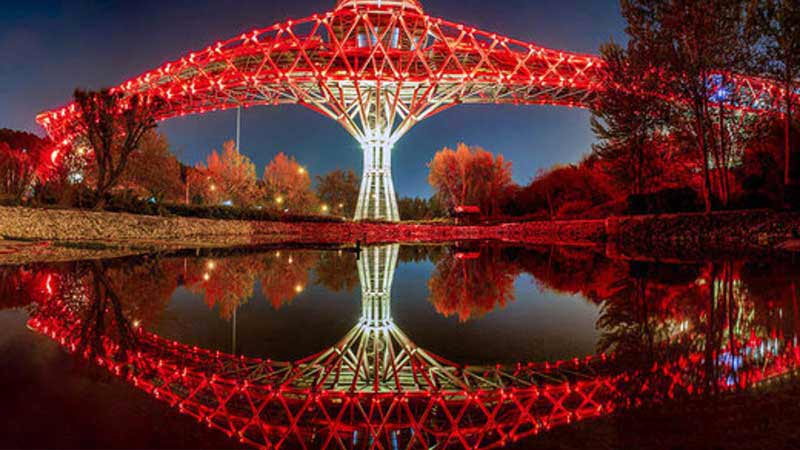
The Concept of the Tabiat Bridge
Designed with an organic, tree-like structure, the Tabiat Bridge is fully environmentally friendly, and its tree-like columns seamlessly extend the continuity of the two green spaces it connects. Leila Araghian, the designer of the Tabiat Bridge, says:
The Tehran Tabiat Bridge was inspired by the Si-o-se-pol bridge in Isfahan, a place named for its 33 arches. However, the feeling it gives visitors is similar to that of Khaju Bridge, a hub for public gatherings, poetry readings, and traditional tea houses.
She explains the design idea:
One day, while walking in Tehran’s alleys with my colleague, we came across a bridge over a river with an old sofa in front of a house. We moved the sofa onto the bridge and thought, why must we always just cross bridges? Why can’t there be a chance to rest on them and experience a new space? This idea stayed with me until the Tabiat Bridge competition came up. The first thing that came to mind was that this bridge should be a place for people to relax and enjoy, to pause and admire the surroundings without rush. Other elements were then added, such as making it winding so the end of the path is not visible, giving people a sense of discovery and freedom.
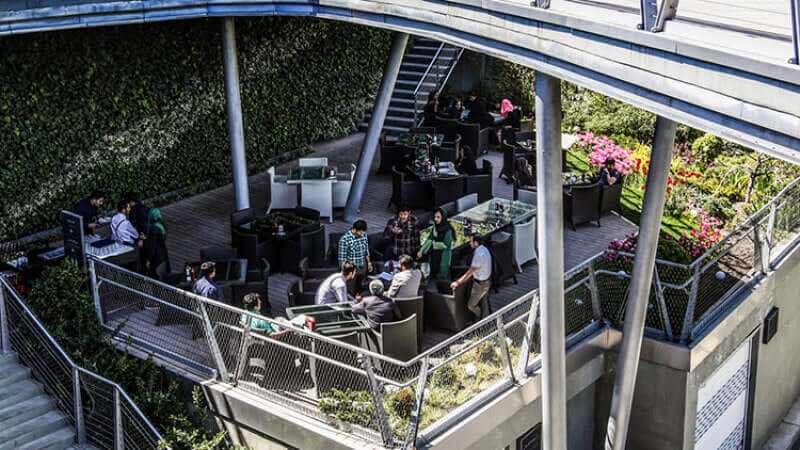
Where is the Tabiat Bridge in Tehran?
The Tabiat Bridge, one of the most beautiful sightseeing spots in Tehran, is built over Modarres Highway, connecting Talaqani Park to Water and Fire Park. Its convenient location makes it easily accessible by metro, bus, personal car, or taxi.
Address: Tehran, Vanak Square, Haqqani Highway, after the Jahankoodak intersection, Water and Fire Park
Accessing the Tabiat Bridge by Metro
To get to the Tabiat Bridge by metro, you can disembark at Shahid Haqqani station on Line 1 and head towards Talaqani Park, reaching the bridge via its beautiful wooden walkway.
If you plan to go to the Tabiat Bridge from Talaqani Park, you can use Haqqani Highway, pass the Jahankoodak intersection and the large bridge, and head to the side street of Talaqani Park, where you can park your car in the large parking lot.
To access the Tabiat Bridge from Water and Fire Park, head north on Jordan (Nelson Mandela) Street, then enter Shahidi Street on Haqqani East Highway. After parking your car, head to the entrance of Water and Fire Park on this street towards the Tabiat Bridge. Note that there are two public parking lots on Shahidi Street.
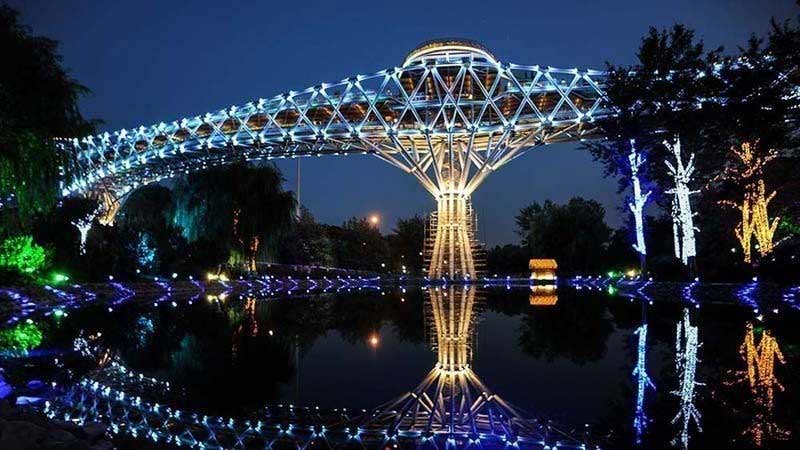
The Floors of the Tabiat Bridge in Tehran
- First Floor: The first floor of the Tabiat Bridge has spaces for food lovers, allowing you to enjoy the delicious tastes of Iranian and international cuisine in a green environment with a scenic view. The food court, one of Tehran’s famous food courts, is located on the eastern side of the bridge and includes several cafes, Iranian restaurants, and fast food outlets, with a capacity of about 300 people. This floor is approximately 1450 square meters, with glass-walled exteriors.
- Second Floor: This floor, around 2870 square meters, offers a cozy space with benches in different areas, allowing you to rest and fully enjoy the peace and beauty.
- Third Floor: The third floor, with an area of 571 square meters, offers an extraordinary view of Tehran, especially at sunset. It’s the best part of the bridge for walking, with two observation decks in the northern and southern parts, perfect for enjoying the surroundings and taking top-quality photos.
As the largest pedestrian pathway in Tehran, the Tabiat Bridge connects Talaqani and Water and Fire Parks in Abbasabad lands, with entrances from both parks. Thus, the Tabiat Bridge serves more than just connecting two points and can be accessed from both sides.
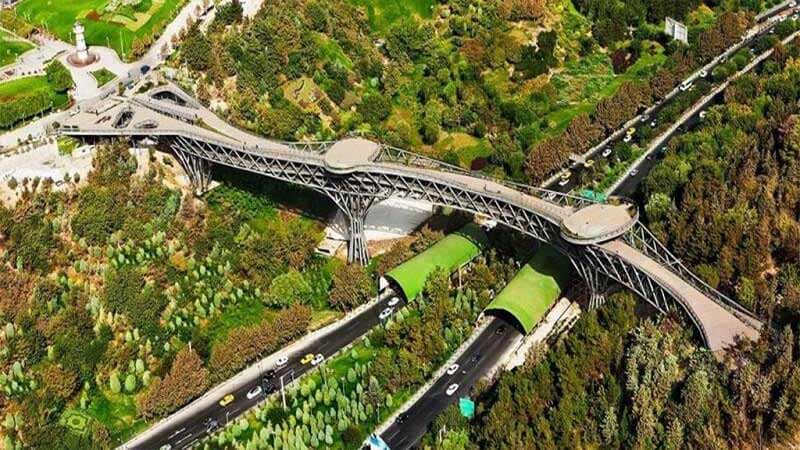
Architecture of the Tabiat Bridge
The Tabiat Bridge comprises three floors, with the first, second, and third floors measuring 1450, 2870, and 571 square meters, respectively. This bridge, 300 meters long and with a total weight of 2000 tons, is the largest non-vehicular bridge in Iran. The bridge’s area is about 7000 square meters, with 480 square meters dedicated to restaurants and cafes and 720 square meters to green space. Five main ideas were considered in the bridge’s design, which are briefly mentioned.
Bridges are usually pathways from one point to another, but this bridge was designed from the outset as a place to stay. When it connects two parks, it can be part of them, with benches, restaurants, and sitting areas for leisure.
The Tabiat Bridge doesn’t just connect two points (parks) but has multiple entries, with its branches leading to different areas of the parks.
Mystery was also a part of this project’s goals. Typically, bridges have a straight path visible from the start. The twists and turns in the Tabiat Bridge prevent seeing the end, adding to its allure.
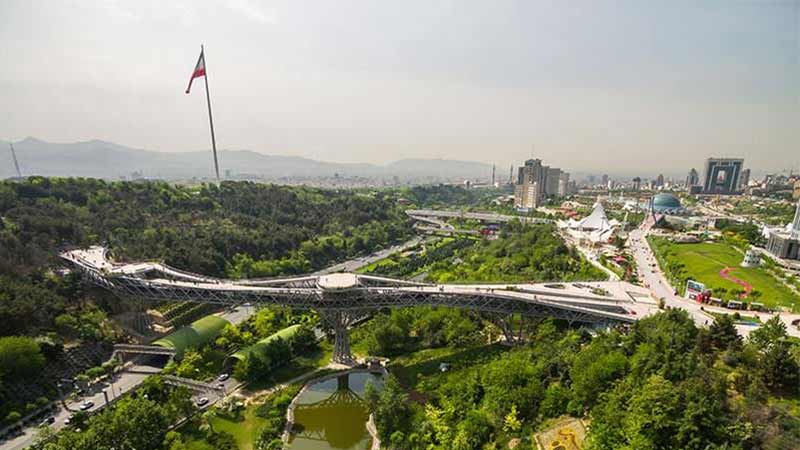
Given the presence of many trees in the two parks on either side of the bridge, the project aimed to choose locations with the fewest trees for the bridge’s columns and endpoints, thereby minimizing environmental impact.
The structure and architecture of the Tabiat Bridge are not separate; the reason for its three-story design was to ensure the bridge’s stability and functionality. All elements of the bridge have contributed to its architectural form and structural stability.
For the construction of the bridge, apart from using special materials and pipes, the highest standards and safety coefficients were observed to ensure the bridge lasts 100 years and withstands earthquakes above seven on the Richter scale. The construction cost was about 18 million dollars. Additionally, one of the unique features of the Tabiat Bridge is the 14,000 steel pieces cut, assembled, installed, and welded at a height of 40 meters above the ground.
Who is the Designer of the Tabiat Bridge?
The architects and designers of the Tabiat Bridge are Leila Araghian and Alireza Behzadi from the “Diba Tensile Architecture” group. Leila Araghian, born on October 10, 1983, graduated with a Bachelor’s in Architecture from Shahid Beheshti University and a Master’s in Architecture from UBC, Canada.
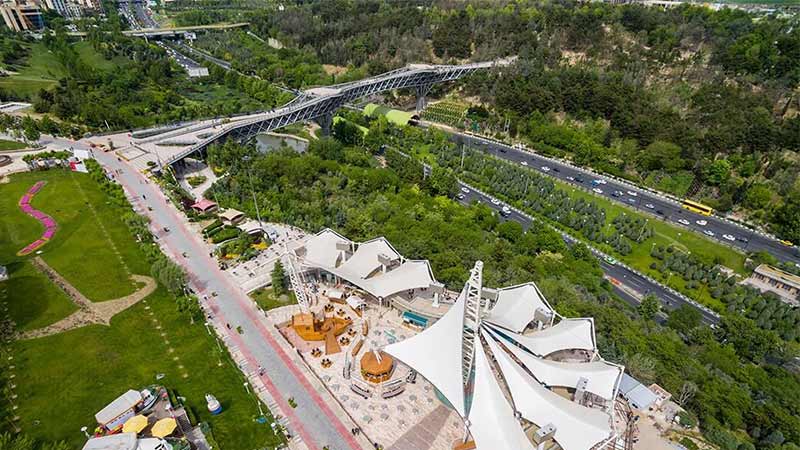
Before the Tabiat Bridge, the design and implementation of two projects, the Amphitheater of Water and Fire park and the Silk Bridge 2 with a flower and plant market cover, as well as small canopies in Bandar Park, were assigned to this company, from which they emerged successfully. Subsequently, they were invited by the officials of the Abbasabad Renovation Company to participate in the pedestrian bridge design competition, where the joint design of Leila Araghian, Alireza Behzadi, and Sahar Yasai was selected as the winning project. The main goal of the bridge’s design was to create a place for staying, while creating furniture and green spaces to connect the two parks, making it part of both.
Conclusion
In summary, Tabiat Bridge in Tehran is more than just a bridge; it’s a unique blend of architecture, nature, and community space. This modern structure, gracefully spanning over a busy highway, not only connects two public parks but also brings people together. Its innovative design and the inclusion of areas for leisure activities make it a popular spot for both locals and tourists. The bridge is a symbol of Tehran’s urban development and evidence to the creativity and forward-thinking of modern Iranian architecture. It stands as a charming oasis in the midst of the busy city, offering a peaceful retreat and stunning views, making it a beloved landmark in Tehran.
Frequently Asked Questions
Where is the Tabiat Bridge?
The Tabiat Bridge is built over Modarres Highway in Tehran, connecting Talaqani Park to Water and Fire Park. Its convenient location makes it easily accessible by metro, bus, personal car, or taxi.
How do we get to the Tabiat Bridge?
To get to the Tabiat Bridge by metro, disembark at Shahid Haqqani station on Line 1 and head towards Talaqani Park to reach the bridge. If you’re coming from Talaqani Park, use Haqqani Highway, pass the Jahankoodak intersection and the large bridge, then head to the side street of Talaqani Park, where you can park in the large parking lot. To access the Tabiat Bridge from Water and Fire Park, go north on Jordan (Nelson Mandela) Street, park your car after the Hemmat Highway exit, and head to the Tabiat Bridge from the Water and Fire Park entrance on Shahidi Street.
Who is the architect of the Tabiat Bridge?
The architect and designer of the Tabiat Bridge are Leila Araghiyan and Alireza Behzadi from the “Diba Tensile Architecture” group. Leila Araghiyan, born on October 10, 1983, holds a bachelor’s degree in architecture from Shahid Beheshti University and a master’s degree in architecture from the University of British Columbia (UBC) in Canada.
How Many Levels Does the Tabiat Bridge Have?
First Level: On the first level of the Tabiat Bridge, there are spaces designated for food enthusiasts, where you can enjoy the delicious tastes of both Iranian and international cuisine in a verdant environment with a scenic view. The food court of the Bridge, located on the eastern side of the bridge, includes several coffee shops, an Iranian restaurant, and fast food outlets, with a capacity for about 300 people. This level covers an area of approximately 1,450 square meters and its walls are covered in glass.
Second Level: This level, which spans about 2,870 square meters, offers a cozy space. Thanks to the benches placed in different parts, you can take a break, relax, and fully appreciate the beauty and tranquility.
Third Level: If you visit the third level of the Tabiat Bridge, which has an area of 571 square meters, the extraordinary view of Tehran, especially at sunset, will take your breath away. This level is the best part of the bridge for walking and strolling; it features two viewing platforms in the north and south parts where you can both enjoy the surrounding scenery and take some fantastic photos.



